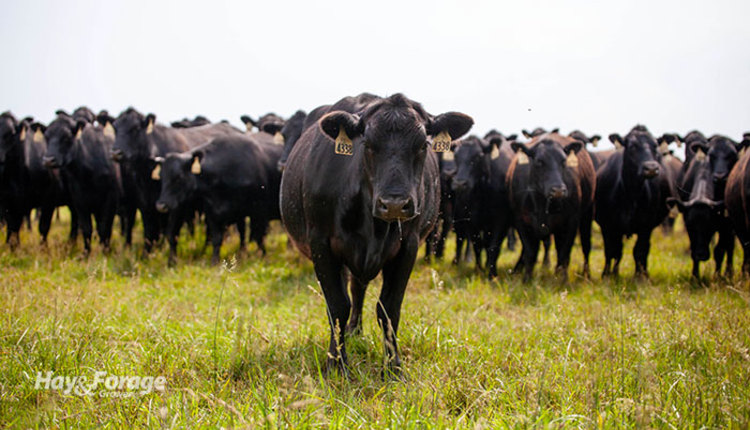
Its complexities are many. It is both a blessing and a curse . . . loved and hated. Many have trouble living with it, but they would never engage the thought of living without it. This is the world of toxic tall fescue, which currently covers millions of acres of prime grazing land in the nation’s Fescue Belt. No other forage species has a geographic region named after it.
The toxic endophyte fungus offers Kentucky-31 tall fescue the longevity of a Galapagos Islands’ tortoise. Who can pass that up from a forage species?
Here’s the problem: The same endophyte fungus that offers seemingly eternal life causes millions of dollars in livestock production losses every year. Perhaps no agricultural fact has been as well documented with research and farmer experience than this one.
So, what’s the answer? It’s easy: DDN — Don’t do nothing.
We are currently in the middle of the so-called dog days of summer when heat, coupled with toxicity, creates a lot of livestock problems. Of course, all of this forage livestock poisoning can be avoided by replacing toxic fields, or at least a portion of them, with novel endophyte tall fescue or some other nontoxic species. That’s often a tough sell, although it probably shouldn’t be.
Plan B’s
If you refuse to send toxic fescue stands to their fatal end, then at least consider implementing one or more of the laundry list of mitigation strategies that will reduce, but not eliminate, the effects of toxic Kentucky-31. As I travel to farms throughout the Fescue Belt, these are the most common approaches encountered.
Late-fall/winter calving: This helps avoid putting the breeding season square in the middle of the time when heat and toxicity both reach a crescendo. It also often means that purchased supplements and hay will be needed to carry lactating cows over until green grass appears again. These systems run counter to the natural animal-forage interface.
Legume interseeding: This falls under the larger heading of dilution being the solution, although legumes can be beneficial in any forage stand. Red clover is an especially effective legume to help offset the impacts of fescue toxicosis, but any clovers are better than no clovers. Be vigilant about routinely seeding legumes into toxic fescue pastures so there’s never a gap.
Supplementation: Research has verified that feed supplementation is an effective means of mitigating fescue toxicosis, and I have been on several beef operations where this strategy appears to be working to the extent that it can.
Supplements such as distillers grains, corn gluten feed, or soy hulls are commonly used. Further improvements in performance can be realized when they’re coupled with the use of an ear implant containing a growth-promoting steroid hormone. Research at the University of Kentucky measured a 70% improvement in average daily gains with the combination of soy hulls and steroid implants compared to pasture-only cattle. Of course, these supplements likely wouldn’t be needed if cattle were off toxic fescue.
Minerals: Free-choice mineral available to cattle is always important, but especially for animals on toxic fescue pastures during the hot days of summer. Compounds that contribute to fescue toxicosis bind to micro minerals such as zinc and copper, reducing the toxic effects to the animal. Avoid feeding trace mineralized salt in place of free-choice minerals or try to cut consumption of the mineral mix by adding salt.
Seedhead suppression/removal: Given the relatively high toxicity of fescue seedheads, it makes sense to keep cattle from consuming them. This can effectively be done with chemical suppression, but it comes with chemical and yield costs. Mechanical removal of seedheads with a mower is also an option, but this isn’t easily accomplished. Timed rotational grazing to let the cows remove grass growing points before they emerge is another option, but this is difficult to do across a large number of acres.
Stockpile: Stockpiling forage, in general, is an effective means of lengthening the grazing season. Stockpiled toxic tall fescue is especially effective because of its ability to grow in the fall, and toxicity levels decline from late fall into the next spring. However, don’t graze stockpiled tall fescue too short, as stem bases can have a high concentration of toxic endophytes during the fall.
Seed something else: This is perhaps the most effective approach to avoiding the evils of toxic fescue when it’s at its worst. With growing frequency, farmers are seeding either summer annual or warm-season grasses to have a place to go with the cow herd during the scorching days of summer. Both options offer a nontoxic alternative with high forage yields. This strategy even makes good sense for those farms with a novel endophyte tall fescue base.
A better approach
All of the above mitigation strategies don’t eliminate the impacts of toxic tall fescue, they merely reduce them to various degrees. Conversion to novel tall fescue varieties is the only way to put the problem in the rearview mirror. I’ve heard all of the reasons why this can’t be done, but they don’t change the fact that profits will continue to suffer if toxic fescue continues to anchor the forage base.

